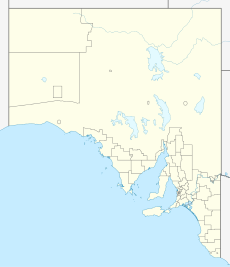Kalka, South Australia
|
Kalka Community South Australia |
|||||||||
|---|---|---|---|---|---|---|---|---|---|
| Coordinates | 26°6′45″S 129°9′11″E / 26.11250°S 129.15306°ECoordinates: 26°6′45″S 129°9′11″E / 26.11250°S 129.15306°E | ||||||||
| Population | 114 (2006 census) | ||||||||
| Postcode(s) | 5710 | ||||||||
| Elevation | 598 m (1,962 ft) | ||||||||
| Location | 700 km (435 mi) by road southwest of Alice Springs | ||||||||
| LGA(s) | Anangu Pitjantjatjara Yankunytjatjara | ||||||||
| State electorate(s) | Giles | ||||||||
| Federal Division(s) | Grey | ||||||||
|
|||||||||
Kalka is an Aboriginal community in the Anangu Pitjantjatjara Yankunytjatjara Lands in South Australia administered under the Anangu Pitjantjatjara Yankunytjatjara Land Rights Act. At the 2006 census, Kalka had a population of 114.
Kalka is situated in the far northwest of South Australia, right alongside the Gunbarrel Highway. The Kalka community is just kilometres from the Surveyor-General's Corner (the intersection of the South Australia, Western Australia and Northern Territory borders). The community of Pipalyatjara is situated 15 kilometres away by road, on the south side of the mountain ridge of which Kalka sits on the north. Kalka is situated at the foot of the Tomkinson Ranges.
Based upon the climate records of the Giles Weather Station which is across the border and slightly to the northwest in Western Australia, Kalka experiences summer maximum temperatures of an average of 37.2 degrees Celsius in January and a winter maximum average temperature of 19.9 degrees Celsius in July. Overnight lows range from a mean minimum temperature of 23.5 degrees in January to 6.8 degrees in June.
Annual rainfall averages 284.2 millimetres.
According to local media, Kalka's population is approximately 150 people.
The Australian Bureau of Statistics' 2001 Census indicated a total population of 139, with 90.6% being Indigenous Australians. The residents are mainly Anangu people with a small non-Anangu population.
...
Wikipedia

